Have you ever wondered what happens to tree roots after stump grinding? Even after the stump is removed and the sawdust settles, a complex network of roots remains hidden beneath the soil’s surface. In the absence of the stump, these roots begin a gradual process of decay, which can impact soil health and even influence the growth of new plants. This article delves into the post-grinding journey of tree roots, shedding light on their role in shaping the future of your garden.
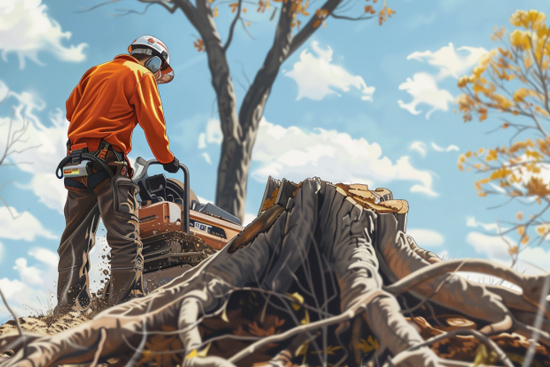
Key Takeaways
• Stump grinding removes the visible stump while leaving an extensive network of roots underneath, slowly decomposing over time.
• After grinding, tree roots may either decay naturally, enriching the soil or, in some species, store energy to sprout new growth even without the trunk.
• Professional stump removal services can efficiently prevent future stump and root regrowth, with expertise in managing the process and landscape health.
The Aftermath of Stump Grinding on Tree Roots
When the roar of the stump grinder fades and the dust settles, you’re left with a seemingly peaceful patch of ground. But beneath the surface, the tree’s extensive root system remains, sprawling out like the veins of the earth. Stump grinding shreds the visible evidence of the tree stump, turning it into a mound of woodchips, yet the hidden network of roots lingers. These subterranean survivors hold tales of resilience and change that influence the future of your garden.
The grinding process might have erased the tree stump from view, but it’s just the first step in a long transition. As we dive deeper, let’s explore how stump grinding affects the tree roots and what that means for your green space, especially when considering the roots after stump grinding.
The Stump Grinding Process
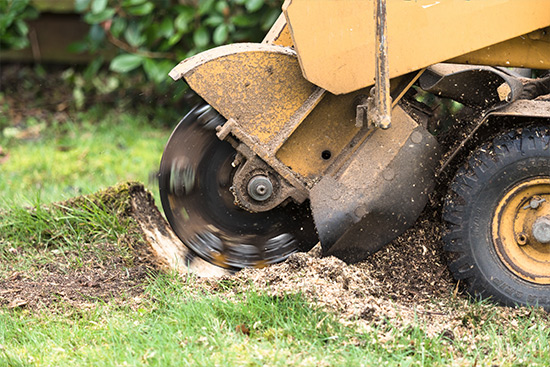
Stump grinding is a powerful dance between man and machine, where the remnants of a felled tree, including tree stumps, are reduced to chips. This process involves tree stump grinding services that:
1. Utilize a specialized stump grinder to shred the tree stump, transforming it into a bed of mulch.
2. Concentrate on grinding the visible part of the tree stump below the ground level.
3. Leave the remaining root system undisturbed beneath the soil.
While the grinder chews through the wood, it also grazes the uppermost parts of the root system, disrupting the surface connections without delving into the depths where the majority of the roots reside. The result is a top layer of mulch and a subterranean network awaiting its fate.
Roots Below the Grind
What remains unseen is as important as what’s visible. The roots below the grind extend their fingers far beyond the stump, reaching outward 4 to 12 feet from their origin. Now disconnected from its source, this hidden lattice of life begins a slow transformation. But what exactly happens to these roots after they’re severed from their trunk?
The roots’ journey post-grind is not a swift one; they don’t vanish overnight. Instead, they gradually descend into decay, with the soil as their final resting place. Let’s delve into the destiny that awaits these remnants of once mighty trees.
The Fate of Tree Roots Post-Grinding
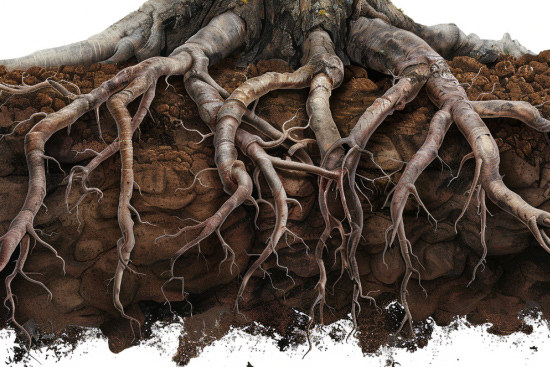
Once the grinding ceases, the roots left behind enter a period of dormancy before they begin their slow decomposition. Over the years, spanning half a decade or more, they transform into part of the soil’s fabric. This natural breakdown depends significantly on the tree species, with hardwood roots taking a leisurely path to decay compared to their softer counterparts.
External factors such as soil composition and climate play a significant role in this process. While most tree roots will eventually return to the earth, those belonging to species with deep taproots might linger longer, holding onto the depths. This process exemplifies nature’s patience and persistence, as well as the strength of a tree’s roots.
Regrowth Potential After Stump Grinding
Yet, in the face of decay, life finds a way to assert itself. When left in nutrient-rich, undisturbed soil, the roots may sprout anew, giving rise to fresh growth. This potential for rebirth is particularly pronounced in aggressive tree species, such as maples and poplars, which seem to defy the finality of the grinding process, even when it appears that the roots die.
These stubborn species store energy within their roots, allowing them to eventually grow new shoots, sometimes directly from the ground where the entire stump once stood. It’s a remarkable demonstration of nature’s tenacity and a reminder that even after a tree stump’s removal, the story might not be over.
Tip: Learn how to prevent new tree growth from its stump, because after cutting a tree and grinding its stump, the last thing you want is for it to grow back.
Impact on Surrounding Soil and Plants
The afterlife of tree roots can be a boon to the surrounding ecosystem. As they decay, they release nutrients back into the soil, enriching it and fostering an environment ripe for new plant growth. This natural recycling of resources bolsters soil fertility and assists in the regeneration of the local flora.
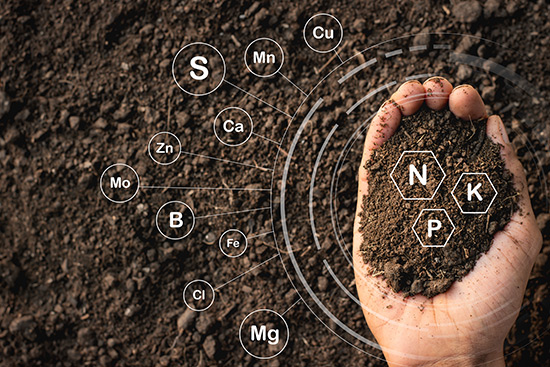
However, this nutrient influx might also incite a battle for resources among plants. The denser growth that results can lead to competition, with some plants thriving while others struggle. It’s a delicate balance that requires thoughtful management to ensure a harmonious landscape.
Managing Root Residue for Landscape Health
Managing the roots left after stump grinding is crucial for maintaining a healthy, aesthetically pleasing landscape. Mulching over exposed roots can both protect them and enhance the look of your garden. Taller ground covers, on the other hand, can shield these roots from foot traffic and add a lush layer to your green space.
It’s not just about looks, though. Fertilizing the soil can help other trees adapt to the changing environment and fend off disease. Filling in any ground depressions with topsoil or compost can prevent uneven terrain and create a solid foundation for new life. With the right approach, the remaining roots can be turned from a nuisance into a benefit for your landscape.
Should You Remove Roots or Let Them Naturally Decay?
The question of whether to remove or let tree roots naturally decay is not always straightforward. In certain situations, root removal might be necessary, such as when planning construction projects or when there’s a risk of pest infestation. Natural decay, however, can enhance soil health, but it can also invite unwanted guests like termites and carpenter ants, which can damage your home.
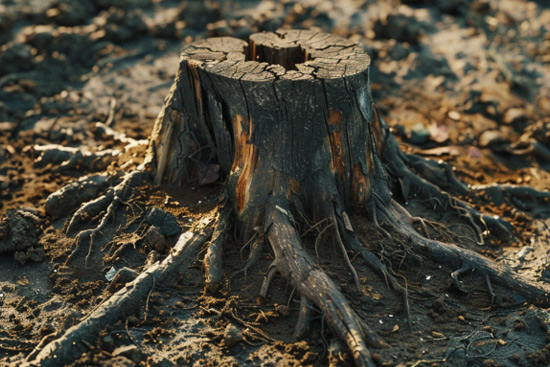
The decision often comes down to balancing immediate needs with long-term landscape health. While removing roots might provide a quick fix, allowing them to decay naturally can offer enduring benefits to the soil and ecosystem.
Mitigating Risks of New Growth
Unwanted new growth can be a persistent challenge, but regular removal of sprouts will gradually exhaust the roots’ stored energy and lead to their decline. Herbicides offer a more aggressive solution, yet they must be wielded with caution to prevent collateral damage to other plants.
Monitoring for new growth and managing it promptly ensures that the remaining roots do not overstep their bounds. This allows for a seamless transition in the landscape and ensures that nutrients are available to the plants you want to thrive.
Enhancing Your Yard Post-Stump Grinding
After the remnants of stump grinding are cleared away, the opportunity to enhance your yard presents itself. Removing the leftover debris is just the beginning; filling the void with fresh soil sets the stage for new growth, be it through sod or grass seed. Laying sod provides instant greenery, while seeding may take time but offers a more natural integration into your existing lawn.
The wood chips left from the grinding can be repurposed as mulch, contributing to soil moisture retention and weed control throughout your garden. With diligent watering and care, your landscape can quickly rebound from the disruption of stump grinding, becoming a lush and vibrant space once again.
Professional Services vs. DIY Approaches
Stump and root removal might seem like a DIY project, but there’s a strong case to be made for professional tree removal services to remove tree stumps. Experts in tree care can prevent regrowth with their knowledge and specialized equipment, ensuring that the roots do not pose future problems. Their arsenal includes chippers and grinders designed to tackle the job efficiently, saving you time and effort.
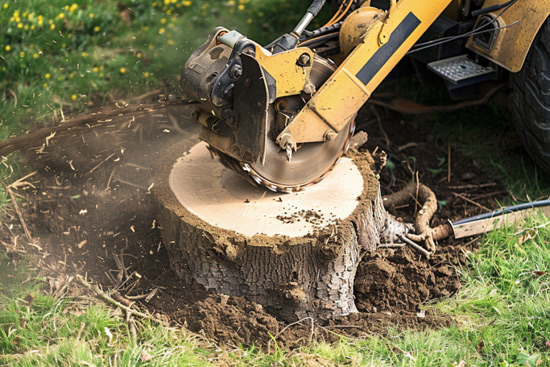
Moreover, professionals understand the nuances of applying the right amount of force to avoid landscape damage, and they manage the entire process from start to finish, including the cumbersome cleanup. For those looking to maintain their property’s value and curb appeal, investing in professional stump removal services can be a time-saving and effective option.
Tree Root and Stump Grinding Summary
We’ve journeyed through the underground world of tree roots and post-stump grinding and discovered the intricate dance between decay and regrowth. Managing this hidden network is key to maintaining a healthy, thriving landscape. Whether you choose to let nature take its course or intervene with hands-on management, each decision shapes the story of your garden. As you ponder the next steps for your outdoor space, may this guide inspire you to create a landscape that resonates with the beauty of renewal and growth.
Frequently Asked Questions
Do tree roots still grow after stump grinding?
Yes, tree roots can continue to grow for a short time after stump grinding, but they will eventually die down, especially for non-aggressive species.
How long does it take for tree roots to decompose after stump grinding?
Depending on the species and soil conditions, tree roots can take 5 to 10 years to decompose after stump grinding.
Can I plant a new tree where the old stump was ground down?
Yes, you can plant a new tree where the old stump was ground down, but it’s best to wait until the remaining roots have decayed considerably to avoid competition for nutrients and space.
Should I be concerned about pests with decaying roots in my yard?
Yes, you should be concerned. Decaying roots can attract pests like termites or carpenter ants, so it’s important to monitor the area and consider pest control measures.
This article was first published on: https://www.72tree.com/what-happens-to-roots-after-stump-grinding/